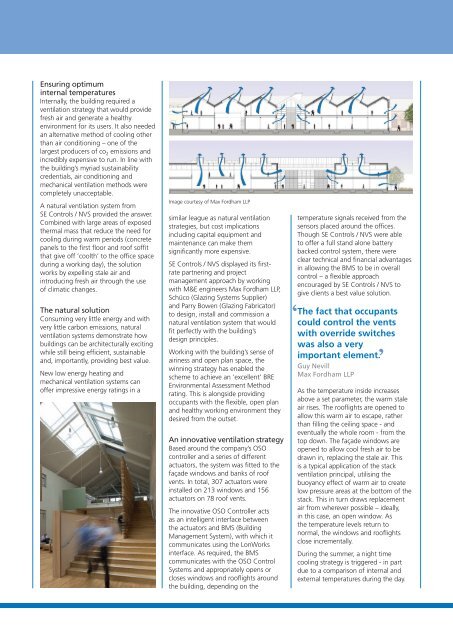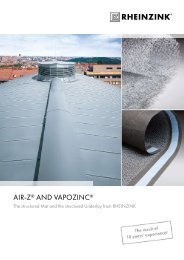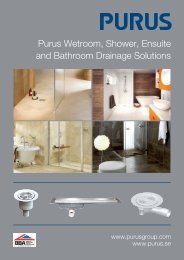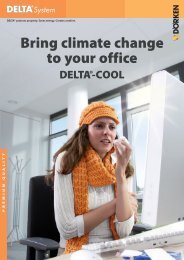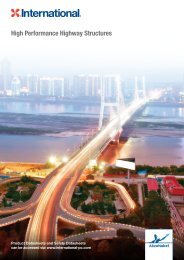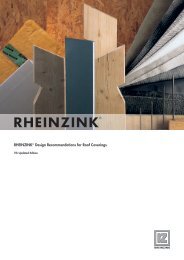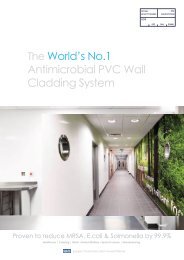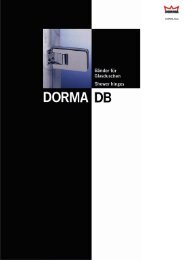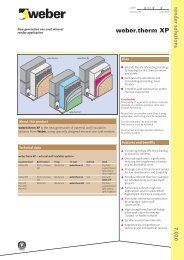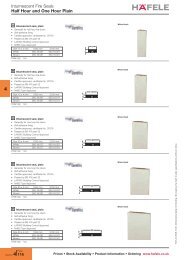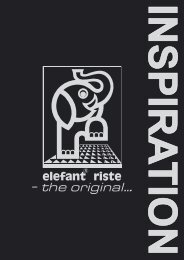Case Study: The National Trust Central Office - RIBA Product Selector
Case Study: The National Trust Central Office - RIBA Product Selector
Case Study: The National Trust Central Office - RIBA Product Selector
You also want an ePaper? Increase the reach of your titles
YUMPU automatically turns print PDFs into web optimized ePapers that Google loves.
Ensuring optimum<br />
internal temperatures<br />
Internally, the building required a<br />
ventilation strategy that would provide<br />
fresh air and generate a healthy<br />
environment for its users. It also needed<br />
an alternative method of cooling other<br />
than air conditioning – one of the<br />
largest producers of co2 emissions and<br />
incredibly expensive to run. In line with<br />
the building’s myriad sustainability<br />
credentials, air conditioning and<br />
mechanical ventilation methods were<br />
completely unacceptable.<br />
A natural ventilation system from<br />
SE Controls / NVS provided the answer.<br />
Combined with large areas of exposed<br />
thermal mass that reduce the need for<br />
cooling during warm periods (concrete<br />
panels to the first floor and roof soffit<br />
that give off ‘coolth’ to the office space<br />
during a working day), the solution<br />
works by expelling stale air and<br />
introducing fresh air through the use<br />
of climatic changes.<br />
<strong>The</strong> natural solution<br />
Consuming very little energy and with<br />
very little carbon emissions, natural<br />
ventilation systems demonstrate how<br />
buildings can be architecturally exciting<br />
while still being efficient, sustainable<br />
and, importantly, providing best value.<br />
New low energy heating and<br />
mechanical ventilation systems can<br />
offer impressive energy ratings in a<br />
Image courtesy of Max Fordham LLP<br />
similar league as natural ventilation<br />
strategies, but cost implications<br />
including capital equipment and<br />
maintenance can make them<br />
significantly more expensive.<br />
SE Controls / NVS displayed its firstrate<br />
partnering and project<br />
management approach by working<br />
with M&E engineers Max Fordham LLP,<br />
Schüco (Glazing Systems Supplier)<br />
and Parry Bowen (Glazing Fabricator)<br />
to design, install and commission a<br />
natural ventilation system that would<br />
fit perfectly with the building’s<br />
design principles.<br />
Working with the building’s sense of<br />
airiness and open plan space, the<br />
winning strategy has enabled the<br />
scheme to achieve an ‘excellent’ BRE<br />
Environmental Assessment Method<br />
rating. This is alongside providing<br />
occupants with the flexible, open plan<br />
and healthy working environment they<br />
desired from the outset.<br />
An innovative ventilation strategy<br />
Based around the company’s OSO<br />
controller and a series of different<br />
actuators, the system was fitted to the<br />
façade windows and banks of roof<br />
vents. In total, 307 actuators were<br />
installed on 213 windows and 156<br />
actuators on 78 roof vents.<br />
<strong>The</strong> innovative OSO Controller acts<br />
as an intelligent interface between<br />
the actuators and BMS (Building<br />
Management System), with which it<br />
communicates using the LonWorks<br />
interface. As required, the BMS<br />
communicates with the OSO Control<br />
Systems and appropriately opens or<br />
closes windows and rooflights around<br />
the building, depending on the<br />
‘<br />
temperature signals received from the<br />
sensors placed around the offices.<br />
Though SE Controls / NVS were able<br />
to offer a full stand alone battery<br />
backed control system, there were<br />
clear technical and financial advantages<br />
in allowing the BMS to be in overall<br />
control – a flexible approach<br />
encouraged by SE Controls / NVS to<br />
give clients a best value solution.<br />
<strong>The</strong> fact that occupants<br />
could control the vents<br />
with override switches<br />
was also a very<br />
important element.<br />
Guy Nevill<br />
Max Fordham LLP<br />
‘<br />
As the temperature inside increases<br />
above a set parameter, the warm stale<br />
air rises. <strong>The</strong> rooflights are opened to<br />
allow this warm air to escape, rather<br />
than filling the ceiling space - and<br />
eventually the whole room - from the<br />
top down. <strong>The</strong> façade windows are<br />
opened to allow cool fresh air to be<br />
drawn in, replacing the stale air. This<br />
is a typical application of the stack<br />
ventilation principal, utilising the<br />
buoyancy effect of warm air to create<br />
low pressure areas at the bottom of the<br />
stack. This in turn draws replacement<br />
air from wherever possible – ideally,<br />
in this case, an open window. As<br />
the temperature levels return to<br />
normal, the windows and rooflights<br />
close incrementally.<br />
During the summer, a night time<br />
cooling strategy is triggered - in part<br />
due to a comparison of internal and<br />
external temperatures during the day.


